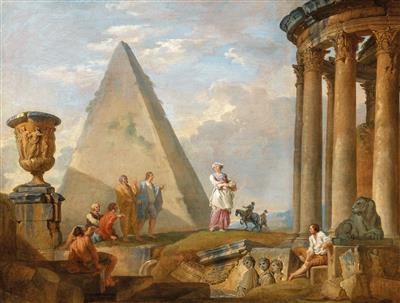Giovanni Paolo Panini

(Piacenza 1691–1765 Rome)
Ruins with a woman preaching (a Sibyl?),
oil on canvas, 48 x 63 cm, framed
Provenance:
Attems collection, Graz;
with Galerie Sanct Lucas, Vienna, 1937;
Private collection, Austria
Literature:
G. Delogu, Novità panniniane, in: Strenna Piacentina, XVI, 938, pp. 137-138, ill.;
F. Arisi, Gian Paolo Panini e i fasti della Roma del ‘700, Rome 1986, p. 326, no. 190
The present painting is a typical example of the idealised view painting by Giovanni Paolo Panini. Arisi proposed a date of circa 1730 (see literature) at which time the artist was established in Rome.
A possible preparatory drawing for this painting is in the Louvre (inv. no. 6726) with differences in some of the architectural fragments in the foreground and some details of the cornice of the temple to the right.
Refering to classical antiquity, Panini revisited the archaeological elements seen in this painting, such as the crater on the left, reminiscent of the so-called Vaso Borghese, the Roman pyramid of Caius Cestius seen in the background and the circular building on the right which appears to be a reference to the Temple of Vesta at Tivoli in other idealised views.
The scene is animated by a number of figures, focusing on a woman in the centre. She may be a sibyl or a prophet. Her character appears in many of the painter’s other idealised views, such as in the Ruins with a woman preaching (a Sibyl?) in the Museo del Prado, Madrid, which shares a similar date to the present work. We also see this figure in one of the pair of pictures held in the Cassa di Risparmio di Piacenza, in which the woman represents a farm girl approaching a fountain to fill a ewer (see Arisi 1986, p. 397, no. 331 and p. 364, no. 265 respectively).
22.10.2019 - 17:00
- Dosažená cena: **
-
EUR 37.800,-
- Odhadní cena:
-
EUR 30.000,- do EUR 40.000,-
Giovanni Paolo Panini
(Piacenza 1691–1765 Rome)
Ruins with a woman preaching (a Sibyl?),
oil on canvas, 48 x 63 cm, framed
Provenance:
Attems collection, Graz;
with Galerie Sanct Lucas, Vienna, 1937;
Private collection, Austria
Literature:
G. Delogu, Novità panniniane, in: Strenna Piacentina, XVI, 938, pp. 137-138, ill.;
F. Arisi, Gian Paolo Panini e i fasti della Roma del ‘700, Rome 1986, p. 326, no. 190
The present painting is a typical example of the idealised view painting by Giovanni Paolo Panini. Arisi proposed a date of circa 1730 (see literature) at which time the artist was established in Rome.
A possible preparatory drawing for this painting is in the Louvre (inv. no. 6726) with differences in some of the architectural fragments in the foreground and some details of the cornice of the temple to the right.
Refering to classical antiquity, Panini revisited the archaeological elements seen in this painting, such as the crater on the left, reminiscent of the so-called Vaso Borghese, the Roman pyramid of Caius Cestius seen in the background and the circular building on the right which appears to be a reference to the Temple of Vesta at Tivoli in other idealised views.
The scene is animated by a number of figures, focusing on a woman in the centre. She may be a sibyl or a prophet. Her character appears in many of the painter’s other idealised views, such as in the Ruins with a woman preaching (a Sibyl?) in the Museo del Prado, Madrid, which shares a similar date to the present work. We also see this figure in one of the pair of pictures held in the Cassa di Risparmio di Piacenza, in which the woman represents a farm girl approaching a fountain to fill a ewer (see Arisi 1986, p. 397, no. 331 and p. 364, no. 265 respectively).
|
Horká linka kupujících
Po-Pá: 10.00 - 17.00
old.masters@dorotheum.at +43 1 515 60 403 |
| Aukce: | Obrazy starých mistrů I |
| Typ aukce: | Salónní aukce |
| Datum: | 22.10.2019 - 17:00 |
| Místo konání aukce: | Wien | Palais Dorotheum |
| Prohlídka: | 12.10. - 22.10.2019 |
** Kupní cena vč. poplatku kupujícího a DPH
Není již možné podávat příkazy ke koupi přes internet. Aukce se právě připravuje resp. byla již uskutečněna.
